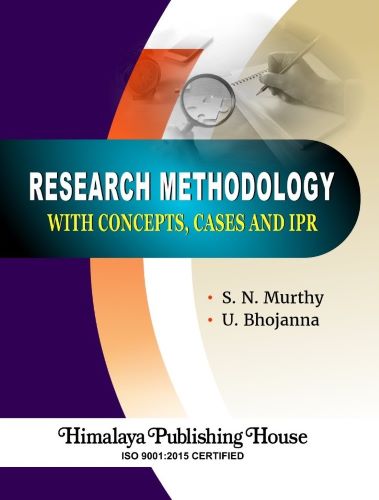Research is the key and the brain for decision-making in an organisation. When students enter the corporate world they need to know the methodology to be adopted to conduct research. The book provides many examples to illustrate the concept of research. This book has made learning systematic. This book aims at covering various aspects of research methodology such as data collection, analysis, interpretation of data and use of statistical methods etc. Many mini-exercises are included at the end of the chapters. The book contains case studies relating to various areas of business research. The book is written in an easy and understandable manner to give knowledge to students about various tools and skills necessary to apply research methods. The book is divided into 26 chapters which includes IPR, its importance in the creative world, role of IPR and its protection.
Contents –
Chapter 1: Research Methodology and Market Research
1.1 Introduction
1.2 Objectives of Research
1.3 Types of Research
1.4 Need for Market Research
1.5 Criteria or Characteristics of a Good Research
1.6 Problems Encountered by Researcher
1.7 Marketing Research
Assignment
Chapter 2: Scientific Method in Research
2.1 Introduction
2.2 Scientific Method
2.3 Why MR Cannot be Considered Scientific?
2.4 Distinction between Scientific and Unscientific Methods
2.5 Difficulties in Applying Scientific Methods to Marketing Research
Chapter 3: Organisation of Marketing Research
3.1 Introduction
3.2 External Organisations for Conducting Marketing Research
3.3 Selection of MR Agencies
3.4 Market Research Organisation
3.5 Importance of Marketing Research (Role)
3.6 Marketing Research and Market Research Distinguished
3.7 Uses of Marketing Research
Chapter 4: Research Process
4.1 What is a Research Problem?
4.2 What is Research Methodology?
4.3 Research Design/Plan
4.4 Steps Involved in Designing a Research / Process
4.5 Distinction between Management Problem and Research Problem
4.6 What is a Research Brief?
4.7 Difference between a Manager and a Researcher
Assignment
Chapter 5: Research Problem Formulation
5.1 Introduction
5.2 Sources for Problem Identification
5.3 Self-Questioning by Researcher while Defining the Problem
Chapter 6: Research Design
6.1 Introduction
6.2 Research Design Framework
6.3 Exploratory Research
6.4 Exploratory Research Methods
6.5 Conclusive Research
6.6 Difference between Exploratory Research and Descriptive Research
Assignments
Chapter 7: Causal Research
7.1 Introduction
7.2 Extraneous Variables
7.3 Concomitant Variable
7.4 Systematic Approach in Solving a Research Problem
7.5 Experimental Research Designs
7.6 Types of Errors Affecting Research Design
7.7 System Approach to Research Design
Assignments
Chapter 8: Secondary Data
8.1 Introduction
8.2 Special Techniques of Market Research or Syndicated Data
8.3 Miscellaneous Secondary Data
8.4 Evaluation of Secondary Data
Assignment
Chapter 9: Literature Review
9.1 Introduction
9.2 Use of Literature Review
9.3 Search for Related Literature
9.4 Reading the Literature
9.5 Guidelines for Information Presentation
9.6 Process of Literature Review
Chapter 10: Primary Data
10.1 Introduction
10.2 Methodology for Collection of Primary Data
10.3 Observation Method
10.4 Survey Research Design
10.5 Survey Methods
10.6 Questionnaire
10.7 Process of Questionnaire Designing
10.8 Pilot Study
10.9 System Approach to Data Collection
10.10 Sample Questionnaires
Assignments
Chapter 11: Qualitative Techniques of Data Collection
11.1 Introduction
11.2 Qualitative Research Methods / Techniques
11.3 Case Study Research Method
114 Interview Method
11.5 Field Administration
Assignments
Chapter 12: Sampling
12.1 Introduction
12.2 Sampling Process
12.3 Types of Sample Design
12.4 Errors in Sampling
12.5 How to Reduce Non-sampling Error?
12.6 Sample Size Decision
Assignments
Chapter 13: Attitude Measurement and Scaling Techniques
13.1 Introduction
13.2 Determinants of Attitude (What Alters the Attitude?)
13.3 Primary Scaling Techniques
13.4 Comparative and Noncomparative Scales
13.5 Comparative Scales
13.6 Non-Comparative Scales
13.7 Criteria for the Good Test
Assignments
Chapter 14: Data Processing and Interpretation
14.1 Introduction
14.2 Steps in Processing of Data
14.3 Statistical Estimation
14.4 Techniques of Interpretation
Assignments
Chapter 15: Statistical Analysis of Business Research
15.1 Introduction
15.2 Bivariate Analysis
15.3 Multivariate Analysis
15.4 Correlation
15.5 Regression
15.6 Analysis of Variance (ANOVA)
15.7 SWOT Analysis
15.8 SPSS Application in MR
Assignment
Chapter 16: Markov Process
16.1 Introduction
16.2 Application of Markov Analysis
16.3 Brand Switching and Brand Loyalty as Applied to Markov Chain
16.4 Transition Matrix
16.5 Steady State Probability
Chapter 17: Hypothesis Testing
17.1 Introduction
17.2 Types of Hypothesis
17.3 Sources of Hypothesis
17.4 Role of Hypothesis
17.5 Characteristics of a Hypothesis
17.6 Steps Involved in Hypothesis Testing
17.7 Errors in Hypothesis Testing
17.8 Univariate/Bivariate Data Analysis
17.9 Types of Hypothesis Tests
Assignment
Chapter 18: Time Series Analysis
18.1 Introduction
18.2 Use of Time Series
18.3 Components of Time Series
18.4 Mathematical Model for Time Series
18.5 Measurement of Trend
18.6 Measurement of Seasonal Variation
18.7 Measurement of Cyclical Variation
18.8 Irregular Variation
Chapter 19: Decision Theory
19.1 Introduction
19.2 Decision-making Categories
19.3 Ingredients of Decision Problem
19.4 Components of Decision-making Environment
19.5 Types of Decision-making Situations
19.6 Value of Information
19.7 Utility as a Decision Criterion
19.8 Decision Tree
Chapter 20: Research Report
20.1 Introduction
20.2 Characteristics of Research Report
20.3 Types of Report
20.4 Preparation of Research Report
20.5 How to Write a Bibliography?
20.6 How to Write a Research Proposal?
20.7 A Case in Point
20.8 Style and Layout of the Report
20.9 Precautions in Report Writing
20.10 Distinction between Report and Essay Writing
20.11 Charting/Graphical Representation of Report
Chapter 21: Ethical Issues in Business Research
21.1 Introduction
21.2 Ethics in the Treatment of the Respondent
21.3 Ethics in the Treatment of Buyers and Clients
21.4 Ethics in the Treatment of Researchers
Assignment
Chapter 22: Market Information System
22.1 Introduction
22.2 Marketing Intelligence System
22.3 Marketing Decision Support Systems (MDSS)
22.4 Distinction between Marketing Intelligence MIS and Marketing Research – A Contrast
Chapter 23: Role of Computers and Recent Trends in Business Research
23.1 Introduction
23.2 Types of Computer System
23.3 Role of Computers in Research
23.4 Important Characteristics of a Computer
23.5 Role of Computers in Different Phases of Research Process
23.6 Recent Trends in Business Research
23.7 Online Survey
23.8 Online – Focus Groups
23.9 Pop-up Surveys
Chapter 24: Application of Marketing Research
24.1 Product Research
24.2 New Product Categories
24.3 Organising New Product Development
24.4 Stages in the Development of New Product
24.5 Morphological Analysis
24.6 Sequential Product Development and Simultaneous Product Development – A Contrast
24.7 Product Testing
24.8 Test Marketing
24.9 Marketing Performance Research
24.10 Advertising Research
24.11 Personal Selling Research
24.12 Brand Image Research
24.13 Distribution Research
24.14 Pricing Research
Chapter 25: Intellectual Property Rights
25.1 Concept of Intellectual Property Rights
25.2 Nature and Characteristics of IPR
25.3 Origin and Development of Intellectual Property
25.4 Kinds of IPR
25.5 Importance of IPR and its Connectivity with Market Economy
25.6 Role of IPR in the Creative World
25.7 TRIPS
25.8 TRIMS
25.9 Industrial Designs
25.10 WIPO
Chapter 26: Guidelines for Project Work
26.1 Introduction
26.2 Preparation of the Report
26.3 List of Some Study Topics
26.4 Formats
Case Studies in Indian Context
Case, Concepts and Chapters Mapping
Statistical Tables
Bibliography
Glossary








Your review is awaiting approval
Muchas gracias. ?Como puedo iniciar sesion?